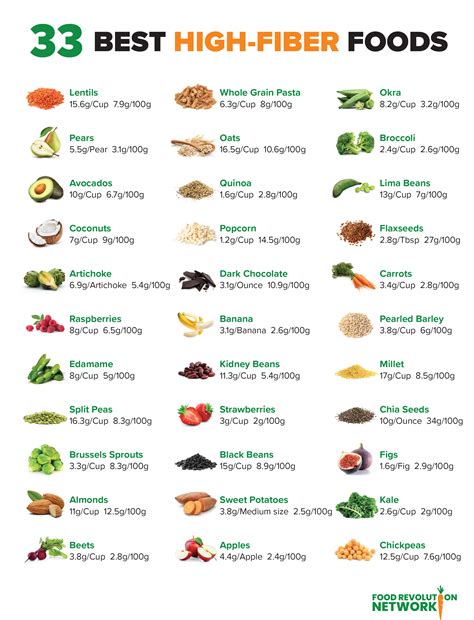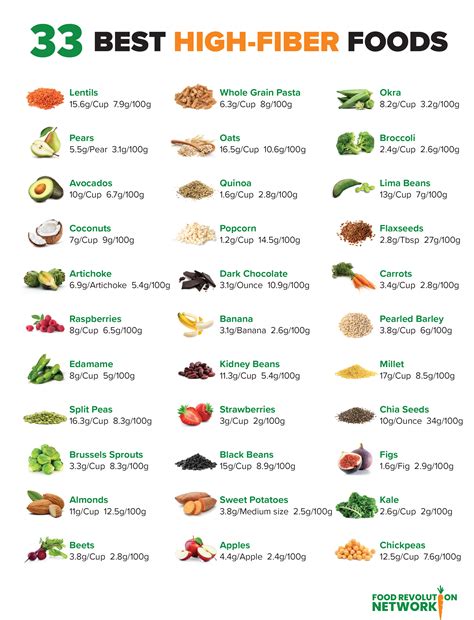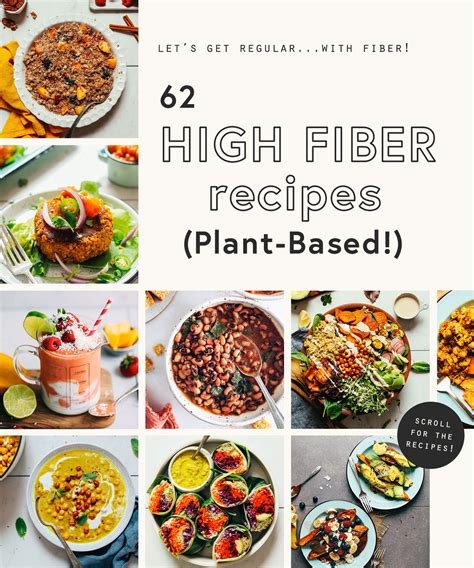Intro
Discover 5 high fiber foods, including fruits, vegetables, and whole grains, that support healthy digestion, boost energy, and promote weight management with soluble and insoluble fiber benefits.
Eating a diet rich in fiber has numerous health benefits, from promoting regular bowel movements to supporting healthy blood sugar levels. Despite its importance, many of us fail to consume enough fiber in our daily diets. The average adult should aim to eat at least 25-30 grams of fiber per day, but the average consumption is often much lower. Incorporating high fiber foods into your meals can help bridge this gap and improve overall health.
Fiber is not only beneficial for digestive health, but it also plays a crucial role in managing weight, reducing the risk of chronic diseases like heart disease and diabetes, and even supporting healthy gut bacteria. With so many benefits, it's essential to understand which foods are high in fiber and how to incorporate them into your daily diet. From fruits and vegetables to whole grains and legumes, there are plenty of delicious and nutritious options to choose from.
Incorporating high fiber foods into your diet can be easy and delicious, with a little planning and creativity. Whether you're looking to boost your energy levels, support healthy weight loss, or simply feel fuller for longer, high fiber foods can help. With their rich nutrient profiles and numerous health benefits, it's no wonder that high fiber foods are a staple in many healthy diets around the world.
Introduction to High Fiber Foods

Benefits of High Fiber Foods
The benefits of eating high fiber foods are numerous and well-documented. Some of the most significant advantages include: * Promoting regular bowel movements and preventing constipation * Supporting healthy blood sugar levels and reducing the risk of diabetes * Lowering cholesterol levels and reducing the risk of heart disease * Aiding in weight loss and maintaining a healthy weight * Supporting healthy gut bacteria and boosting the immune systemTop 5 High Fiber Foods

How to Incorporate High Fiber Foods into Your Diet
Incorporating high fiber foods into your diet can be easy and delicious, with a little planning and creativity. Here are some tips to get you started: * Start your day with a high fiber breakfast, such as oatmeal with fruit and nuts or whole grain toast with avocado and eggs. * Snack on high fiber fruits and vegetables, such as apples, carrots, and berries. * Use legumes like lentils and chickpeas in soups, stews, and curries. * Choose whole grains like brown rice, quinoa, and whole wheat bread instead of refined grains. * Add nuts and seeds like almonds, chia seeds, and flaxseeds to your meals and snacks for an extra boost of fiber and nutrients.High Fiber Food Recipes

Common Mistakes to Avoid When Eating High Fiber Foods
While high fiber foods are nutritious and beneficial for health, there are some common mistakes to avoid when incorporating them into your diet. Here are some tips to keep in mind: * **Increase fiber intake gradually**: Suddenly increasing your fiber intake can cause digestive discomfort, such as bloating and gas. Increase your fiber intake gradually to allow your gut bacteria to adjust. * **Drink plenty of water**: Fiber can be constipating if you don't drink enough water, so make sure to stay hydrated when eating high fiber foods. * **Choose whole foods over supplements**: While fiber supplements can be convenient, they're not a substitute for whole foods. Choose whole, unprocessed foods like fruits, vegetables, and whole grains for the best nutritional benefits.Conclusion and Final Thoughts

Final Recommendations

Call to Action

Additional Resources

What are the benefits of eating high fiber foods?
+Eating high fiber foods can help promote regular bowel movements, support healthy blood sugar levels, and reduce the risk of chronic diseases like heart disease and diabetes.
How much fiber should I eat per day?
+The average adult should aim to eat at least 25-30 grams of fiber per day, although individual needs may vary.
What are some high fiber foods that I can easily incorporate into my diet?
+Some high fiber foods that are easy to incorporate into your diet include avocados, lentils, chickpeas, berries, and whole grains like brown rice and quinoa.
